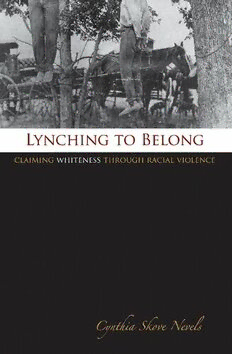Table Of Contentg
Lynching to Belong
Number 106:
Centennial Series of the Association of Former Students,
Texas A&M University
AA44338855..iinnddbb ii 77//1199//0077 1111::1122::5577 AAMM
AA44338855..iinnddbb iiii 77//1199//0077 1111::1122::5599 AAMM
Lynching
to Belong
Claiming Whiteness
through Racial Violence
Cynthia Skove Nevels
Texas A&M University Press
College Station
AA44338855..iinnddbb iiiiii 77//1199//0077 1111::1122::5599 AAMM
Copyright © 2007 by Cynthia Skove Nevels
Manufactured in the United States of America
All rights reserved
First edition
Th e paper used in this book meets the minimum requirements
of the American National Standard for Permanence
of Paper for Printed Library Materials, z39.48-1984.
Binding materials have been chosen for durability.
(cid:2)(cid:2)
Library of Congress Cataloging-in-Publication Data
Nevels, Cynthia Skove, 1955–
Lynching to belong : claiming Whiteness through racial violence /
Cynthia Skove Nevels. — 1st ed.
p. cm. — (Centennial series of the Association of Former Students,
Texas A&M University ; no. 106)
Includes bibliographical references and index.
isbn-13: 978-1-58544-589-9 (cloth : alk. paper)
isbn-10: 1-58544-589-4 (cloth : alk. paper)
1. Brazos County (Tex.)—Race relations—History—19th century. 2. Brazos
County (Tex.)—Race relations—History—20th century. 3. Whites—Race
identity—Texas—Brazos County—History. 4. European Americans—Race
identity—Texas—Brazos County—History. 5. Immigrants—Texas—Brazos
County—Social conditions. 6. Immigrants—Texas—Brazos County—Attitudes—
History. 7. Racism—Texas—Brazos County—History. 8. African Americans—
Crimes against—Texas—Brazos County—History. 9. Lynching—Texas—Brazos
County—History. 10. Violence—Texas—Brazos County—History. i. Title.
f392.b84n485 2007
305.8009764′242—dc22
2007007624
AA44338855..iinnddbb iivv 77//1199//0077 1111::1122::5599 AAMM
To Bob
AA44338855..iinnddbb vv 77//1199//0077 1111::1133::0011 AAMM
AA44338855..iinnddbb vvii 77//1199//0077 1111::1133::0011 AAMM
Contents
List of Illustrations viii
Acknowledgments ix
Introduction 1
Chapter 1 The Banner County 9
Chapter 2 A White Man’s Town 31
Chapter 3 The Italians 64
Chapter 4 The Irish 95
Chapter 5 The Bohemians and the Jews 118
Chapter 6 Conclusion 150
Notes 163
Bibliography 175
Index 183
AA44338855..iinnddbb vviiii 77//1199//0077 1111::1133::0022 AAMM
Illustrations
Map of Brazos County, Texas 13
Parker-Bernath House, built in 1885 17
Main Street, Bryan, around 1870 27
Lynching of Reddick, Whitehead, and Johnson on Boonville Road,
1896 37
Th omas C. Nunn, elected sheriff of Brazos County, 1890 58
Parker Lumber Company 69
Brazos County Jail, built in 1878 71
East side of Bryan, looking along 26th Street from Main Street 72
Bryan Fire Department 80
Cavitt House, built in 1875 125
Josef Blazek 134
Josephine and Joseph Blazek 135
Central Hotel, Bryan, around 1915 140
Ursuline convent central building, “Villa Maria” 147
J. Allen Myers’s hardware store, Main Street 151
AA44338855..iinnddbb vviiiiii 77//1199//0077 1111::1133::0022 AAMM
Acknowledgments
I owe thanks beyond measure to Walter Buenger, and to David Vaught
and Sylvia Grider at Texas A&M University, where the idea for this project
fi rst germinated. Th eir enthusiastic support, helpful advice, and research
knowledge made this undertaking possible. Dr. Buenger, who served as my
committee chair, allowed me to pursue this project according to my own
instincts and on my own timetable, and for that freedom I am grateful in-
deed. Without his continuing help and counsel, this project would not have
reached book form. Dr. Vaught’s ardent belief in the value of good writing
challenged me to let no sentence slide by without examining it for greater
clarity. To Dr. Grider I owe a new appreciation of the value of tangible re-
sources; cemeteries are now among my favorite places in which to conduct
research.
My great regret is that Robert Calvert, whose knowledge of Texas his-
tory never failed to astonish me, did not live long enough to see this research
completed. As the graduate adviser at the time I started my academic stud-
ies, he was a superb cheerleader, and without his welcoming encouragement
I would never have begun. Th anks are also due to Walter Kamphoefner for
helpful discussions about Germans in Texas. I am grateful to Dale Baum,
who probably knows more than anyone else living about Brazos Valley
history and politics, for reading and commenting on an early version of
a chapter. Sarah Alpern deserves special acknowledgment. Her infectious
interest in women’s history, and her enthusiastic response to a graduate pa-
per I wrote for her on ladies and lynching laid the groundwork for what
eventually became this book. Carol Higham provided early encouragement
and direction, and her ability to fi nd humor in the most macabre history
off ered both relief and inspiration. I am also deeply grateful for the care-
ful attention James SoRelle and William D. Carrigan gave to earlier ver-
sions of the manuscript and for the important suggestions they made for its
improvement.
It is impossible to adequately thank Bill Page at the Texas A&M Uni-
versity Library, whose research collections and encyclopedic knowledge of
Brazos County history shaved off years of research time for me. But for him
AA44338855..iinnddbb iixx 77//1199//0077 1111::1133::0022 AAMM

